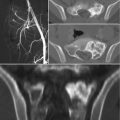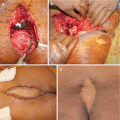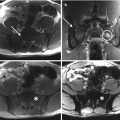© Springer International Publishing AG 2017
Pietro Ruggieri, Andrea Angelini, Daniel Vanel and Piero Picci (eds.)Tumors of the Sacrum10.1007/978-3-319-51202-0_2020. Anatomy and Surgical Approaches to the Sacrum
(1)
Sarcoma Department, H. Lee Moffitt Cancer Center, 12902 Magnolia Drive, Tampa, FL 33602, USA
20.1 Introduction
The treatment of tumors of and around the sacrum is complex, even in the most experienced hands. As such, a thorough understanding of the anatomy of the sacrum and its relations to the vast array of surrounding structures is of utmost importance. With this understanding, and the histology and location of the tumor being treated, the needed surgical approach can be chosen: from limited anterior sacroiliac exposure for benign tumors to combined anterior and posterior approaches for total sacrectomy in the treatment of large sacral chordomas.
In this chapter, we set out to describe the bony anatomy of the sacrum and how it relates to the pelvis, and its contents, as a whole. The relevant neurovascular structures within and adjacent to the sacrum will also be detailed. Additionally, surgical approaches to the sacrum will be described. Both anterior and posterior approaches, as well as combined approaches, will be detailed. Finally, consideration will be paid for how these approaches affect soft tissue reconstruction.
20.2 Anatomy of the Sacrum
20.2.1 Bony Anatomy
The sacrum is a large bone of the axial skeleton, formed from the fusion of the S1 through S5 sacral vertebrae. It is triangular in shape and articulates with four other bones: the L5 vertebra, the left and right innominate bones, and the coccyx. Centrally there is the sacral canal, through which the continued lumbosacral dural sac sits, transmitting the sacral nerve roots. Of note, the dural sac most often ends at the S2 sacral body, with the remainder of the sacral nerve roots exiting caudally. The lateral projections of the sacrum, whose articular cartilage-covered lateral surface forms the sacral surface of the sacroiliac joint, are referred to as the sacral alae. Anteriorly, within the pelvis, the sacrum is curved in shape in both the axial and sagittal planes and tilted such that the super portion of the sacrum faces slightly anterior; this allowed for expanded volume within the pelvis. There are four pairs of anterior sacral foramina, out of which exit the sacral nerve roots. These lie directly lateral to the transverse sacral ridges, which demarcate the fusion lines between the fused sacral vertebrae.
Dorsally, the sacrum is narrower when compared to the anterior surface and also convex is shape. In the midline is the median sacral crest, which is delineated by up to four tubercles that represent the fused sacral vertebrae’s spinous processes. Lateral to the median sacral crest is a relatively flat surface formed from the fused transverse processes that are the origin of the multifidus muscle. Lateral to this surface are the four pairs of posterior sacral foramina, out of which exits the posterior sacral nerves. The most lateral portion of the posterior sacrum is overhung, but not the posterior ilium and posterior inferior iliac spine. Most caudally, the sacral hiatus is present, near the articulation with the coccyx, and represents the most caudal extent of the sacral canal.
The lateral surfaces of the sacrum are somewhat triangular in shape, with the cranial portion being broader than the caudal portion. The majority of the lateral sacrum is comprised of the sacral portion of the sacroiliac joint, is convoluted in geography, and is covered in articular cartilage. The thin, inferior-most edge of the lateral sacrum is called the inferior lateral angle, off of which a bony projection comes. Inferior to this is where the fifth sacral nerve exits. The inferolateral-most portion of the sacrum is the attachment point for the sacrospinous and sacrotuberous ligaments, along with some origin fibers of the gluteus maximus and coccygeus.
20.2.2 Ligamentous Anatomy
There are three general areas of ligamentous attachment to the sacrum: cranially at the lumbosacral articulation, laterally at the sacroiliac joints, and inferiorly with the sacrospinous and sacrotuberous attachments.
The lumbosacral articulation lies at the L5–S1 intervertebral disk. The usual ligamentous attachments of the lumbar spine exist between the L5 vertebra and the S1 portion of the sacrum.
There are three ligaments, per side, that constitute the sacroiliac ligament complex: the anterior sacroiliac ligament, the interosseous sacroiliac ligament, and the posterior sacroiliac ligaments. Anteriorly, the anterior sacroiliac ligament is a thin structure that traverses the entirety of the sacroiliac joint capsule. It is not separable from the joint capsule itself. The interosseous ligament lies just anterior to the posterior ligament complex and is formed by near horizontal fibers that directly connect the ilium to the sacrum. The posterior sacroiliac ligament complex is the most substantial of the ligaments attaching the sacrum to the ilium. This complex is composed of a short posterior sacroiliac ligament, which lies just posterior to the interosseous ligament and has horizontal fibers, and the long posterior sacroiliac ligament, which runs vertically cranially from the posterior superior iliac spine to caudally at the lateral portion of the S3 and S4 segments.
The sacrospinous and sacrotuberous ligaments originate from the inferior lateral portion of the sacrum, with the sacrotuberous ligament sharing some origin fibers with the posterior sacroiliac ligaments. The ischial attachments of the sacrospinous and sacrotuberous ligaments are the ischial spine and the ischial tuberosity, respectively.
20.3 Surgical Approaches to the Sacrum
20.3.1 Anterior Approach to the Sacroiliac Joint
The anterior approach to the sacroiliac joint is a reliable, reproducible, and safe approach that can provide direct access to the entire anterior joint and lateral sacral ala. This can be a useful approach for resection, curettage, and adjuvant treatment of lateral sacral tumors that are being treated using marginal or intralesional treatment principles.
20.3.1.1 Description of Approach
The patient is positioned supine on the operating table, with the option of placing a bump under the ipsilateral buttock. An incision is made along the margin of the iliac crest starting several centimeters proximal and posterior to the anterior superior iliac spine and extending 2–3 cm distal to the anterior superior iliac spine. Once through subcutaneous fat, incise the fascia and periosteum overlying the outer table of the iliac crest, and carry this subperiosteal dissection over the brim of the iliac crest. This, in effect, is dissecting the attachment of the abdominal wall musculature to allow for suitable closure. At this point, the iliacus, whose origin is the inner table of the ilium, is encountered and can be freed from the inner table bluntly. This is often best done using a Cobb elevator and a laparotomy sponge. This dissection is carried all the way to the sacroiliac joint. Several perforating blood vessels will be encountered, which will need to be cauterized or controlled with firm placement of bone wax. This dissection can be carried all the way to the lateral border of the sacral foramina; dissection should not be carried medial to this point, unless necessary, as there is considerable risk of damage to the anterior sacral nerve roots. Cranially, caution should be exercised, as the L5 nerve root can be encountered as it crosses the brim of the sacral ala. Hohmann retractors can be placed directly into the sacrum medially, as long as care is taken not to inadvertently place the point of the retractor into the sacral foramen. Closure is fairly simple, requiring only reapproximation of the abdominal musculature fascia, subcutaneous tissue, and fat.
Stay updated, free articles. Join our Telegram channel

Full access? Get Clinical Tree






